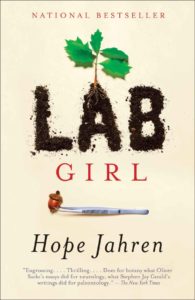 Lab Girl. Hope Jahren. New York: Knopf, 2016. 304 pages. ISBN 9781101874936
Lab Girl. Hope Jahren. New York: Knopf, 2016. 304 pages. ISBN 9781101874936
Letters, words, sentences, chapters, figures, tables, articles, issues, books, and volumes—each of these items inform, sharing an anticipated quantity of truth, or perhaps notifying us that the “matching lid” we’ve been using has been misplaced. Lab Girl uses alternating chapters of personal and professional memoir (a format I greatly enjoyed) including “Part One: Roots and Leaves,” “Part Two: Wood and Knots,” and “Part Three: Flowers and Fruit,” to weave a captivating and educational tale. Originally I listened to the audiobook version and delighted in the author’s tone, slowing my intake in order to clarify some of the most meaningful accounts as they were recapped. I later added the hardback version to my bookshelf providing easy access to the excerpts; some hilarious and others cautionary. It also serves as a visual reminder for me to appreciate the fact that attending annual meetings rarely includes an icy road trip with peers (or in vans).
Jahren’s love for the lab, and the story, both get under way in her father’s introductory physics and earth science lab at a Midwestern Community College. Her quest for knowledge leads to an increasingly widening radius of locations (University of California, Berkeley; Georgia Institute of Technology; Johns Hopkins University; and University of Hawaii) as her career, her laboratory, the navigation of the scientific-grant obstacle course, and her keen writing of scientific papers to flourish. You will learn about, or be reminded of, botany while reading this book. Descriptions of cotyledons, inconceivably patient seeds, and tap roots all educate the reader while driving home points about the interconnected lives we lead.
Folded within the embryo are the cotyledons: two tiny ready-made leaflets, inflatable for temporary use. They are as small and insufficient as the spare tire that is not intended to take you any further than the nearest gas station. Once expanded with sap, these barely green cotyledons start up photosynthesis like an old car on a bitter winter morning. Crudely designed, they limp the whole plant along until it can undertake the construction of a true leaf, a real leaf. Once the plant is ready for a real leaf, the temporary cotyledons wither and are shed; they look nothing like all the other leaves that the plant will grow from this point forward.
—Hope Jahren
Extremely personal topics are also front and center in Lab Girl as the investigator and subject focuses the lens internally. Her relationship with an emotionally distant family provides just enough humor to promote introspection. Detailing her experience with mania in a vulnerable and educational, discourse took me by surprise and left me strikingly aware of how much we all have to learn. I hope she writes a sequel.
Anna Jester is Director of Sales and Marketing at eJournalPress.
